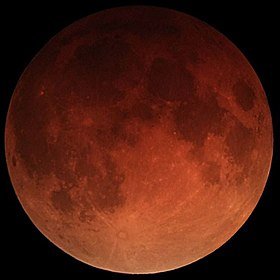
A lunar eclipse occurs when the Moon passes directly behind Earth and into its shadow. This can occur only when the Sun, Earth, and the Moon are aligned (in syzygy) exactly or very closely so, with the planet in between. Hence, a lunar eclipse can occur only on the night of a full moon. The type and length of an eclipse depend on the Moon's proximity to either node of its orbit.
During a total lunar eclipse, Earth completely blocks direct sunlight from reaching the Moon. The only light reflected from the lunar surface has been refracted by Earth's atmosphere. This light appears reddish for the same reason that a sunset or sunrise does: the Rayleigh scattering of bluer light. Due to this reddish color, a totally eclipsed Moon is sometimes called a blood moon.
Unlike a solar eclipse, which can be viewed only from a certain relatively small area of the world, a lunar eclipse may be viewed from anywhere on the night side of Earth. A total lunar eclipse lasts a few hours, whereas a total solar eclipse lasts only a few minutes as viewed from any given place, due to the smaller size of the Moon's shadow. Also unlike solar eclipses, lunar eclipses are safe to view without any eye protection or special precautions, as they are dimmer than the full Moon.
For the date of the next eclipse, see the section Recent and forthcoming lunar eclipses